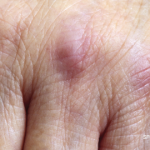Prognostic Factors in Polymyositis and Dermatomyositis
By Robyn T. Domsic, MD
Bronner IM, van der Meulen MFG, de Visser M, et al. Long-term outcome in polymyositis and dermatomyositis. Ann Rheum Dis. 2006 Nov;65(11):1456-1461.
Abstract
Background: Although polymyositis and dermatomyositis are regarded as treatable disorders, prognosis is not well known, because long-term outcome and prognostic factors vary widely in the literature.
Aim: To analyze the prognostic outcome factors in polymyositis and adult dermatomyositis.
Methods: The authors determined mortality, clinical outcome (muscle strength, disability, persistent use of drugs, and quality of life), and disease course and analyzed prognostic outcome factors.
Results: Disease-related death occurred in at least 10% of the patients, mainly because of associated cancer and pulmonary complications. Re-examination of 110 patients after a median follow-up of five years showed that 20% remained in remission and were off drugs, whereas 80% had a polycyclic or chronic continuous course. The cumulative risk of incident connective tissue disorder in patients with myositis was significantly increased. Sixty-five percent of the patients had normal strength at follow-up, 34% had no or slight disability, and 16% had normal physical sickness impact profile scores. Muscle weakness was associated with higher age (odds ratio [OR] 3.6; 95% confidence interval [CI] 1.3 to 10.3). Disability was associated with male sex (OR 3.1; 95% CI 1.2 to 7.9). Forty-one percent of the patients with a favorable clinical outcome were still using drugs. Jo-1 antibodies predicted the persistent use of drugs (OR 4.4, 95% CI 1.3 to 15.0).
Conclusions: Dermatomyositis and polymyositis are serious diseases with a disease-related mortality of at least 10%. In the long term, myositis has a major effect on perceived disability and quality of life, despite the regained muscle strength.
Commentary
Several retrospective studies in the last 30 years have addressed the prognosis of patients with polymyositis and dermatomyositis. From these studies, certain trends are notable: a sizable mortality rate ranging from 5% to more than 50%, with the highest mortality in those with malignancy; a chronic continuous disease course in the majority of cases; high levels of subsequent disability; and association of poor outcomes with several factors (older age, presence of interstitial lung disease, esophageal dysfunction, respiratory muscle weakness, or cardiac involvement). While early studies likely included patients with inclusion body myositis (IBM), subsequent studies are more cognizant of the importance of distinguishing IBM from polymyositis. However, diagnostic uncertainty remains.
Bronner and colleagues attempt to address the dilemma of prognosis in myositis by asking two questions. The first question is whether polymyositis and dermatomyositis are associated with different prognosis. The second question is whether the presence of specific autoantibodies affects the clinical course.

